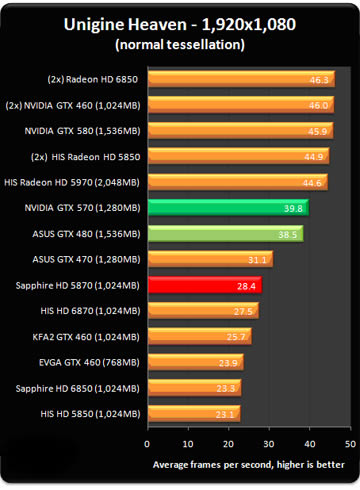Bringing the best from Fermi
Having recently introduced a new GPU architecture in the form of the GeForce GTX 580, NVIDIA has now expanded the 500-series range to include a high-end card that falls within the £300 price bracket.
Dubbed the GeForce GTX 570, the new addition is armed with a revised GF110 core and aims to offer roughly the same level of performance as the previous top-end GeForce GTX 480 in a leaner, cooler and quieter overall package.
Priced at around £280 - over £100 less than the range-topping GeForce GTX 580 - NVIDIA's trimmed-down alternative is designed to offer ample performance without breaking the bank. Here's how the GeForce GTX 570's key features slot in to the high-end desktop range:
| GPU | NVIDIA GeForce GTX 580 1,536MB | NVIDIA GeForce GTX 570 1,280MB | NVIDIA GeForce GTX 480 1,536MB | NVIDIA GeForce GTX 470 1,280MB |
| Transistors | 3.0bn | 3.0bn | 3.0bn | 3.0bn |
| Die size | 520mm² | 520mm² | 529mm² | 529mm² |
| Fermi revision | GF110 | GF110 | GF100 | GF100 |
| General clock | 772MHz | 732MHz | 700MHz | 607MHz |
| Shader clock | 1,544MHz | 1,464MHz | 1,401MHz | 1,215MHz |
| Memory clock | 4,008MHz | 3,800MHz | 3,696MHz | 3,206MHz |
| Memory interface | 384-bit, 1,536MB GDDR5 | 320-bit, 1,280MB GDDR5 | 384-bit, 1,536MB GDDR5 | 320-bit, 1,280MB GDDR5 |
| Memory bandwidth | 192.4GB/s | 152GB/s | 177.4GB/s | 133.9GB/s |
| Shaders | 512 | 480 | 480 | 448 |
| GFLOPS | 1,581 | 1,405 | 1,345 | 1,089 |
| L2 cache | 768KB | 640KB | 768KB | 640KB |
| Texturing | 64ppc bilinear 64ppc FP16 | 60ppc bilinear 60ppc FP16 | 60ppc bilinear 30ppc FP16 | 56ppc bilinear 28ppc FP16 |
| ROPs | 48 | 40 | 48 | 40 |
| ROP rate | 37.1 | 29.3 | 33.6 | 24.28 |
| GTexel/s bilinear | 49.4 | 35.1 | 42 | 33.99 |
| FP16 rate | 49.4 | 35.1 | 21 | 17 |
| Board power (TDP) | 244W | 219W | 250W | 215W |
| HDMI | 1.4a | 1.4a | 1.4a | 1.4a |
| Retail price | £399 | £280 | £300 | £185 |
As the table suggests, the new GeForce GTX 570 is in some ways identical to the previous graphics performance king: GeForce GTX 480. Both feature 15 PolyMorph engines (out of a possible 16) and an identical number of Streaming Multiprocessors that each hold 32 CUDA cores.
The numbers show that the GTX 570 loses out in terms of memory bandwidth - a faster speed isn't enough compensation for a bus-width snip - and falls foul of the GTX 480's 48 raster back-ends when looking at the pure ROP rate and bilinear fill-rate. But where the GTX 570 hits back is with higher out-the-box speeds; core, shader and memory frequencies are set at an impressive 732MHz, 1,464MHz and 3,800MHz, respectively.
The speeds make GTX 570 a match for GTX 480, but the card is of course a toned-down derivative of GTX 580. Compared to the NVIDIA's current crown jewel, GTX 570's core, shader and memory clocks are reduced; the memory interface is cut from 384 bits to 320 bits; shaders see a snip from 512 to 480, and raster back-ends fall from 48 to 40.
What makes the card particularly interesting is that it's able to offer GTX 480-like performance in a better overall package at around the same price. Using the same vapour-chamber technology found on the GTX 580, the new GeForce GTX 570 is able to run cooler and quieter, and improved architecture efficiency lowers the cards TDP to 219W. That's almost on par with GeForce GTX 470.
The combination of green power credentials and high-end performance is usually a winning formula, and GeForce GTX 570 is no exception.
Performance
Leading technology review sites have shown that GeForce GTX 570 performance is almost identical to GeForce GTX 480, and the new GPU manages to eke out a slight advantage in certain benchmarks.

Performance at the £280 price point is exceptional and in many scenarios the GeForce GTX 570 stands out as one of the fastest single-GPU graphics card available. As expected, the second-best GeForce is roughly 15 per cent slower than range-topping GTX 580, but the GTX 570 is, importantly, over £100 cheaper.
With lower operating temperatures, reduced power consumption and minimal noise, the GeForce GTX 570 is an excellent proposition and has the graphical grunt required to play today's modern games at high resolutions. The card shows the true worth of the Fermi architecture, but there's a twist in this tale; AMD will soon launch its competing Radeon HD 6970/6950 'Cayman' cards, and we've yet to see how the GTX 570 will fare against the new Radeon parts.













